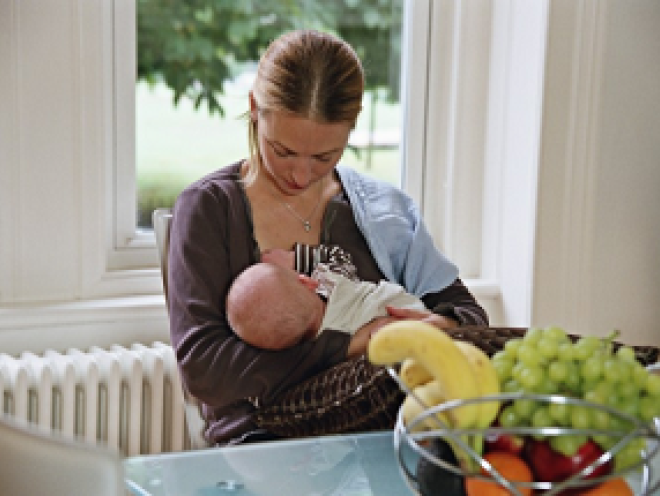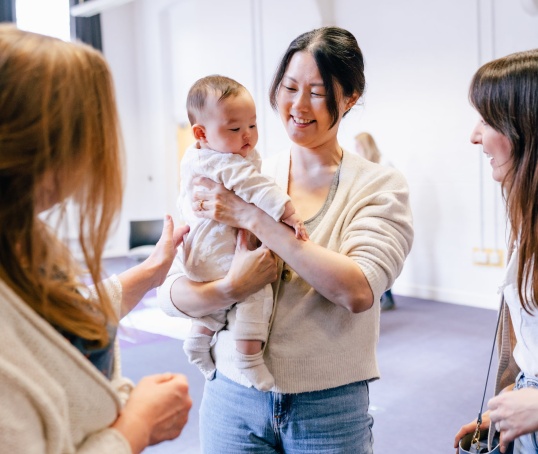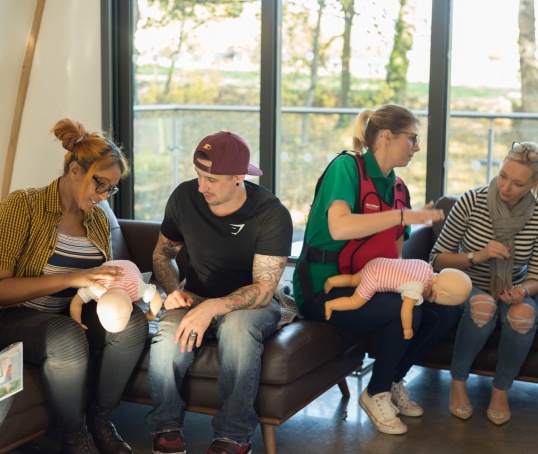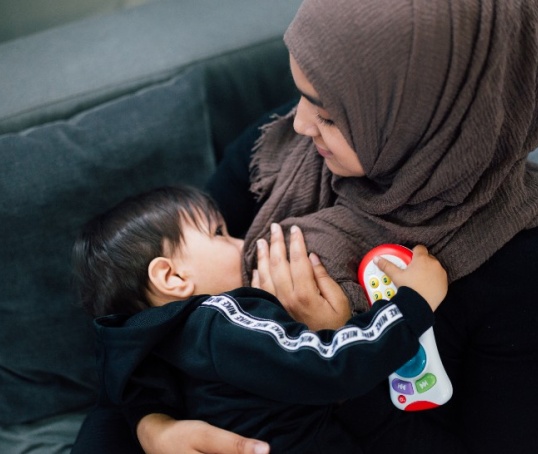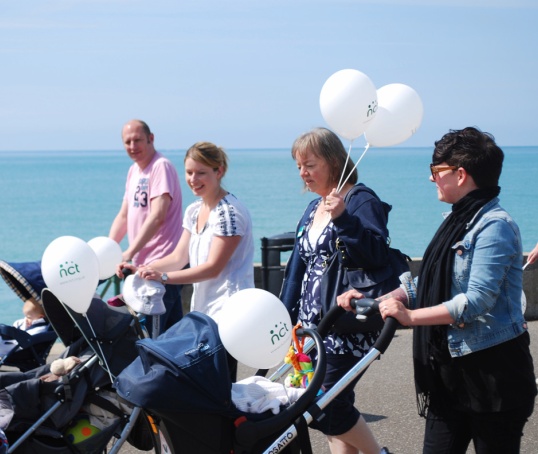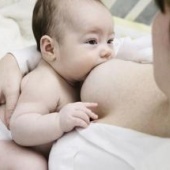Babies biting when you breastfeed is painful. So here we explain why it happens and give you some tips to help stop your baby from biting you.
Some babies never bite, some do it once or twice and others are more persistent (Taylor, 2017). So here's some useful information on this painful phenomenon…
Teething babies and biting while breastfeeding
Occasionally, a baby has one or more teeth at birth but usually teeth start to erupt between six and nine months of age (Lyttle et al, 2015). So your baby will probably get their first tooth sometime during their first year (NHS, 2019).
Yet there’s no need to stop breastfeeding once your baby starts teething. The World Health Organization recommends exclusive breastfeeding up to six months and continued breastfeeding alongside complementary foods up to two years or older (WHO, 2021).
When babies are comfortably and effectively attached to the breast, their tongue covers the bottom gum, which means they cannot bite while they’re actively nursing (Mohrbacher, 2020). Sometimes, women breastfeeding an older baby or a toddler do say they experience biting.
Why do some babies bite when breastfeeding?
A newborn baby might clamp down or, if they have teeth, bite in response to a change in position or to slow or stop the milk flow (Lyttle et al, 2015).
Babies and toddlers who are teething might bite down in the same way as they do on mouth toys and other objects. Our articles Feeding and teething: how to help them with the pain and Teething tips: five things to try discuss teething in more detail.
Some babies bite when they are frustrated by too little milk (Mohrbacher, 2020). Offering more frequent feeds will help maintain milk supply and might mean your baby is less hungry when coming to the breast.
For other babies, the way they attach to the breast could mean their tooth or teeth press into the flesh causing the mum pain, even though they’re not actually biting down. This might get worse when the teeth first cut through — babies may change their latch a bit when they get new teeth because things feel different (Bonyata, 2018a). This problem often resolves itself when the baby learns how to hold their tongue in a way that accommodates their new teeth (Taylor, 2017).
8 Tips: how to stop your baby biting during breastfeeding
- Some mums find that offering something cold to chew before breastfeeding helps reduce the likelihood of biting.
- Keep a finger at the ready so you can break the suction quickly if your baby does try to bite (Mohrbacher, 2013).
- If your baby does bite, take them off the breast and offer something else to bite on instead (Mohrbacher, 2013).
- When your baby bites, it sometimes helps to briefly try pulling your baby closer, as this may encourage them to let go (Taylor, 2017).
- Your baby might not actually be biting but nipping because of where their teeth are in relation to your areola. If that’s the case, think about ways you can position your baby differently so their mouth is in a different place. Feeding in a more reclined position can encourage your baby to latch more deeply. If you’re finding feeding uncomfortable, a laidback breastfeeding position often helps.
- Offering plenty of attention during a feed (Taylor, 2017) and praise when your baby doesn’t bite (Mohrbacher, 2020) might encourage them to breastfeed comfortably.
- If you carefully watch what your baby is doing, you might be able to notice behaviour that leads to biting or the feed coming to an end. That way, you can recognise when to take your baby off before they bite (Mohrbacher, 2020).
- Shouting can be a natural reaction to pain when a baby bites. But it’s best to avoid shouting deliberately in case this encourages your baby to bite for the reaction or leads to breast refusal (Bonyata, 2018a).
Can I predict when my baby will bite during breastfeeding?
If biting tends to happen at the beginning of a feed, positioning your baby so their weight is well supported and their head is tilted back might help (Bonyata, 2018a).
As mentioned earlier, some babies who bite at the beginning of a feed do this to stop or slow the milk flow. So ensuring that their latch is as effective as possible will help them cope better (Boynata, 2018b; Morhbacher, 2020). For more information on latching, see How to help your baby attach and breastfeed.
A lot of mums find it particularly helpful to watch their baby at the start of the feed. If the milk flow looks like it’s about to overwhelm your baby, taking them off can be a good solution to preventing biting (Boynata, 2018b; Morhbacher, 2020).
Some babies who bite do so at the end of a feed when they’ve started to lose interest. Giving feeds your full attention while you’re teaching your baby not to bite will allow you to watch for this happening and break off the feed when you see the early signs (Morhbacher, 2020). This could also be useful if your baby is biting to attract your attention (Bonyata, 2018a).
Common experiences with biting during breastfeeding
"My baby bit me a few days ago, and I called out in pain, frightening him. Since then he’s been difficult to feed and gets upset when I try to put him on."
This is sometimes called a 'nursing strike' and is described in Breastfeeding: my baby’s feeding patterns have changed. It can be reassuring to know that it is almost always temporary.
Some mums find it easier to feed at night or when their baby is sleepy. Skin to skin, having a bath with the baby, patience and calm will often do the trick. You can also access Breastfeeding support from NCT to help you get back on track.
As time goes by, your baby is likely to forget the association between breastfeeding and the scare. Expressing breastmilk can be useful to protect the milk supply if the nursing strike goes on.
"My nipple has developed a crack where my baby bit me on a couple of occasions, and it’s very painful to feed from that side. I’m confident she’s attached just fine, and it’s the damage from the bite that’s causing the pain."
Experimenting with different ways of positioning a growing baby might help. We talk about this in Breastfeeding: which positions are best for you.
If you can’t improve things by changing position, resting the damaged nipple by feeding on one side only might be an option. Your other breast will increase production to match your baby’s needs (Bonyata, 2018b).
You will probably find you need to express your milk on the unused side for your comfort. This will also help to maintain supply while you wait for that nipple to heal (Bonyata, 2018b).
Where to go for feeding support?
You can speak to one of our NCT Breastfeeding Counsellors about any aspect of feeding your baby by calling the NCT Infant Feeding Line on 0300 330 0700. We are open from 8am to midnight every day.
Make friends with other parents-to-be and new parents in your local area for support and friendship by seeing what NCT activities are happening nearby.
This page was last reviewed in January 2022.
Further information
We support all parents, however they feed their baby. If you have questions, concerns or need support, you can speak to a breastfeeding counsellor by calling our support line on 0300 330 0700, whether you are exclusively breastfeeding or using formula milk. Breastfeeding counsellors have had extensive training, will listen without judging or criticising and will offer relevant information and suggestions.
You might find attending one of our NCT New Baby courses helpful as they give you the opportunity to explore different approaches to important parenting issues with a qualified group leader and other new parents in your area.
Make friends with other parents-to-be and new parents in your local area for support and friendship by seeing what NCT activities are happening nearby.
National Breastfeeding Line (government funded): 0300 100 0212.
Bonyata K. (2018a) When baby bites. Available at: https://kellymom.com/ages/older-infant/biting/ [Accessed 4th January 2022].
Bonyata K. (2018b) Lopsided! What can I do? Available at: https://kellymom.com/bf/got-milk/lopsided/ [Accessed 4th January 2022].
Lyttle C, Stoops F, Welbury R, Wilson N. (2015) Tooth eruption and teething in children. The Pharmaceutical Journal. 295: 7883. Available at: https://www.pharmaceutical-journal.com/cpd-and-learning/learning-article/tooth-eruption-and-teething-in-children/20069598.article?firstPass=false [Accessed 4th January 2022].
Mohrbacher N. (2020) Breastfeeding answer; A guide to helping families. Nancy Mohrbacher Solutions, Arlington Heights, IL.
NHS. (2019) Baby teething symptoms. Available at: https://www.nhs.uk/conditions/pregnancy-and-baby/teething-and-tooth-care/[Accessed 4th January 2022.
Taylor E. (2017) Help! My baby bit me! La Leche League GB. Available at: https://www.laleche.org.uk/help-baby-bit/ [Accessed 4th January 2022].
WHO. (2021) Infant and young child feeding. Available at: https://www.who.int/en/news-room/fact-sheets/detail/infant-and-young-child-feeding [Accessed 4th January 2022].
